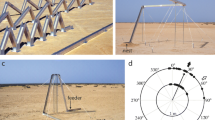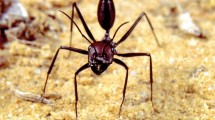Abstract
Desert ants Cataglyphis fortis have been shown to be able to employ two mechanisms of distance estimation: exploiting both optic flow and proprioceptive information. This study aims at understanding possible interactions between the two possibly redundant mechanisms of distance estimation. We ask whether in Cataglyphis the obviously minor contribution of optic flow would increase or even take over completely if the ants were deprived of reliable proprioceptive information. In various experimental paradigms ants were subjected to passive horizontal displacements during which they perceived optic flow, but were prohibited from active locomotion. The results show that in desert ants active locomotion is essential for providing the ants’ odometer and hence its path integrator with the necessary information.




Similar content being viewed by others
References
Duelli P (1976) Distanzdressuren von getragenen Ameisen (Cataglyphis bicolor Fabr.). Rev Suisse Zool 83:413–418
Egelhaaf M, Warzecha AK (1999) Encoding motion in real time by the fly visual system. Curr Opin Neurobiol 9:454–460
Esch HE, Burns JE (1995) Honeybees use optic flow to measure the distance of a food source. Naturwiss 82(1):38–40
Fourcassie V, Dahbi A, Cerdá X (2000) Orientation and navigation during adult transport between nests in the ant Cataglyphis iberica. Naturwissenschaften 87:355–359
Hochberg Y, Tamhane AC (1987) Multiple Comparisons Procedures. Wiley, New York
Hrncir M, Jarau S, Zucchi R, Barth FG (2003) A stingless bee (Melipona sminigra) uses optic flow to estimate flight distances. J Comp Physiol A 189:761–768
Kern R, Petereit C, Egelhaaf M (2001) Neural processing of naturalistic optic flow. J Neurosci 21:1–5
Kruskal WH, Wallis WA (1952) Use of ranks in one-criterion variance analysis. J Am Stat Assoc 47:583–621
Ronacher B, Wehner R (1995) Desert ants Cataglyphis fortis use self-induced optic flow to measure distances travelled. J Comp Physiol A 177:21–27
Sommer S, Wehner R (2005) Vector navigation in desert ants, Cataglyphis fortis: celestial compass cues are essential for the proper use of distance information. Naturwissenschaften 92:468–471
Srinivasan MV, Zhang S, Altwein M, Tautz J (2000) Honeybee navigation: nature and calibration of the “odometer”. Science 287:851–853
Tautz J, Zhang S, Spaethe J, Brockmann A, Si A, Srinivasan MV (2004) Honeybee odometry: performance in varying natural terrain. PLoS Biol 2(7):0915–0923
Ugolini A (1987) Visual information acquired during displacement and initial orientation in Polistes gallicus (L.) (Hymenoptera, Vespidae) Anim Behav 35:590–595
Wehner (1982) Himmelsnavigation bei Insekten. Neurophysiologie und Verhalten. Neujahrsbl Naturforsch Ges Zürich 184:1–132
Wehner R (2003) How miniature brains solve complex tasks. J Comp Physiol A189:579–588
Wehner R, Srinivasan MV (2003) Path integration in insects. In: Jeffery KJ (ed) The neurobiology of spatial behaviour. Oxford University Press, Oxford, pp 9–30
Wittlinger M, Wehner R, Wolf H (2006) The ant odometer: stepping on stilts and stumps. Science (in press)
Wohlgemuth S, Ronacher B, Wehner R (2001) Ant odometry in the third dimension. Nature 411:795–798
Wohlgemuth S, Ronacher B, Wehner R (2002) Distance estimation in the third dimension in desert ants. J Comp Physiol A 188:273–281
Acknowledgments
We thank Andrew Martin for help in conducting the experiments. The research was funded by the Volkswagen-Stiftung (1/78 580) and the Swiss National Science Foundation (3100-61844) both to R.W.. The experiments performed in this study comply with the “Principles of animal care”, publication No. 86-23, revised 1985 of the National Institute of Health and also with the laws of Tunisia, where the experiments were performed.
Author information
Authors and Affiliations
Corresponding author
Rights and permissions
About this article
Cite this article
Seidl, T., Knaden, M. & Wehner, R. Desert ants: is active locomotion a prerequisite for path integration?. J Comp Physiol A 192, 1125–1131 (2006). https://doi.org/10.1007/s00359-006-0148-z
Received:
Revised:
Accepted:
Published:
Issue Date:
DOI: https://doi.org/10.1007/s00359-006-0148-z




